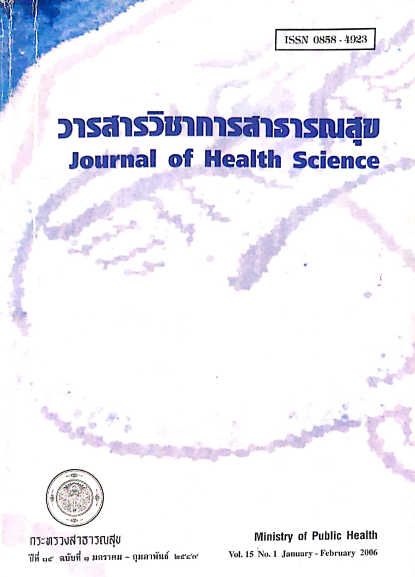Research Series of Thai Health Care Financing: Part 1 Financial Care Coverage in Thailand
Keywords:
long term projection, universal health care coverage, earmarked sin tax, personal health taxAbstract
Universal health care coverage (UC) is an important policy by the Thai government, 75 percent of population covered by the scheme, but the capitation rate did not adequately match with the utilization rate and cost of services. While rely totally on government annual budget, its long-term fiscal sustainability is a worrying problem. This study was conducted during January - December 2004 in order to provide financial reform options for UC scheme. Long term projection of total national health expenditure of Thailand between 2004 and 2020 was constructed using four models namely Demographic and Labour Model, Economic Model, National Health Expenditure Model and Government Model. Several information from various sources were retrieved, for example; population and economic information from National Economic and Social Development Boaed, labour statistic from National Statistical Office, National Health Account of Thailand 1994-2001 from International Health Policy Program and government expenditure from National Economic and Social Development Board from International Health Policy Program and government expenditure from the Comptroller General's Department, Ministry of Finance. Moreover, many possible assumptions were applied in these models and three scenarios of reducing UC expenditure and/or ensuring adequate budget for UC were created in order to illustrate financial implications.
The model estimates showed that the total national health expenditure was around 3.50 percent of GDP in 2004 and it would increase, thereafter, to 3.64 and 3.88 percent of GDP in 2010 and 2030 respectively. The first scenario simulated the effects of the suggested revenue increases by intro ducing personal health tax and additional excise tax on tobacco, alcohol and beer of which some proportion automatically earmarked to UC Fund. This scenario resulted in substantial reductions in the government budget subsidy to the scheme compared to the status quo. The second scenario was produced based on assumptions that Social Security Office would expand its coverage to non-working spouse and dependents of the contributors. Its effects were that the expenditure of UC reduces by around 9,210 million baht in 2005. The first and second scenarios, combined together into the third scenario, suggested it showed that UC almost funded itself with limited additional subsidy from the government.
Three policy recommendations on the scheme financial reform were provided. The first was an earmarked sin tax with or without increase in the sin tax rate. The second was the expansion of social security scheme health benefit to non working spouse and dependents of the contributors, without increasing financial contribution. The last was the reform of Traffic Accident Protection Act (TAP). The Department of Land Transport would be outsourced to collect premium directly from car owners, during the mandatory annual renewal of car license, this would enhance law enforcement. The scheme would cover all victims of traffic accidents not with standing the insurance status of motor vehicles.
Downloads
Downloads
Published
How to Cite
Issue
Section
License
Copyright (c) 2019 Journal of Health Science

This work is licensed under a Creative Commons Attribution-NonCommercial-NoDerivatives 4.0 International License.







